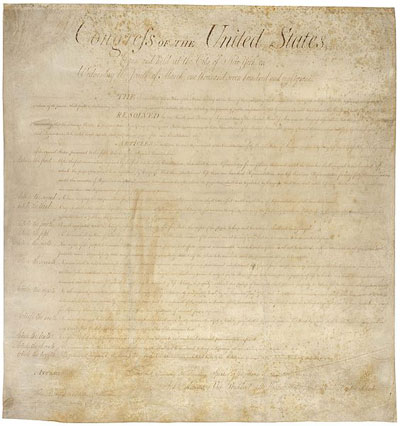
On Sept. 25, 1789, the first Congress of the United States approved 12 amendments to the recently adopted U.S. Constitution, and sent them to the states for ratification. Ten of the 12 were ratified within two years, becoming the first 10 amendments to the Constitution. Known as the Bill of Rights, they have become the cornerstone of what Americans see as their most basic democratic rights: freedom of speech, press, assembly, and religion. These are embodied in the First Amendment, perhaps the most famous part of the Constitution.
The amendment says, “Congress shall make no law respecting an establishment of religion, or prohibiting the free exercise thereof; or abridging the freedom of speech, or of the press; or the right of the people peaceably to assemble, and to petition the Government for a redress of grievances.”
This has been the basis on which landmark mass struggles have been fought and won over the past two centuries, including the struggle against slavery and for equality for African Americans, the women’s rights movement, the battle to organize labor unions, the civil rights movement, and a host of others.
Other Bill of Rights amendments guarantee the right to privacy (Fourth Amendment) and to fair legal procedures (Fifth, Sixth, Seventh and Eighth Amendments). These have been put under stress many times in our history, including in the McCarthy period of anti-communist witch-hunts, in the struggles over women’s reproductive rights and judicial issues like the death penalty, and in the current controversy over government phone and electronic surveillance of ordinary Americans.
The meaning of the Second Amendment is hotly debated today. It says, “A well regulated Militia, being necessary to the security of a free State, the right of the people to keep and bear Arms, shall not be infringed.” Does that apply to individual civilian possession of multi-round automatic assault weapons? A well-funded right-wing lobby argues “yes,” while many others, horrified by what is called an epidemic of shocking gun violence, say “no.”
Like the rest of the Constitution and the other amendments that were adopted later, the meaning and application of the Bill of Rights adopted more than 220 years ago continue to be developed and contested in life. But they remain the centerpiece of what Americans mean when they think about democracy.
Photo: Bill of Rights. (Note that the First Amendment is actually “Article the third” on the document, Second Amendment is “Article the fourth”, and so on. “Article the second” is the 27th Amendment. “Article the first” was never ratified.) Wikimedia Commons












Comments